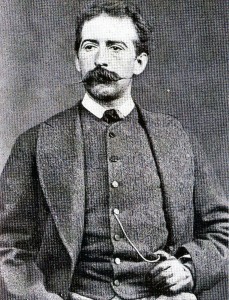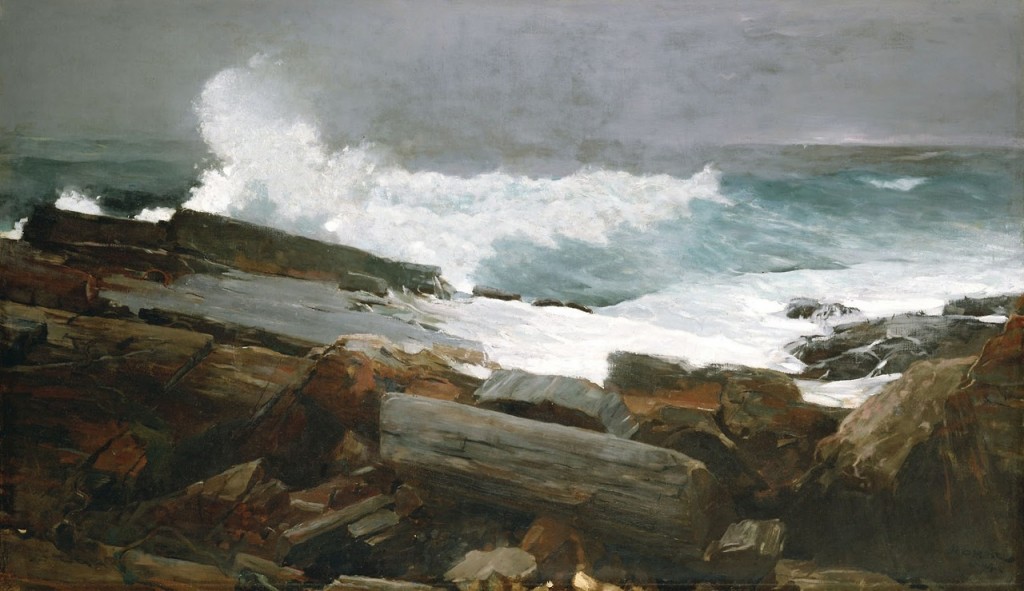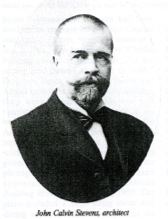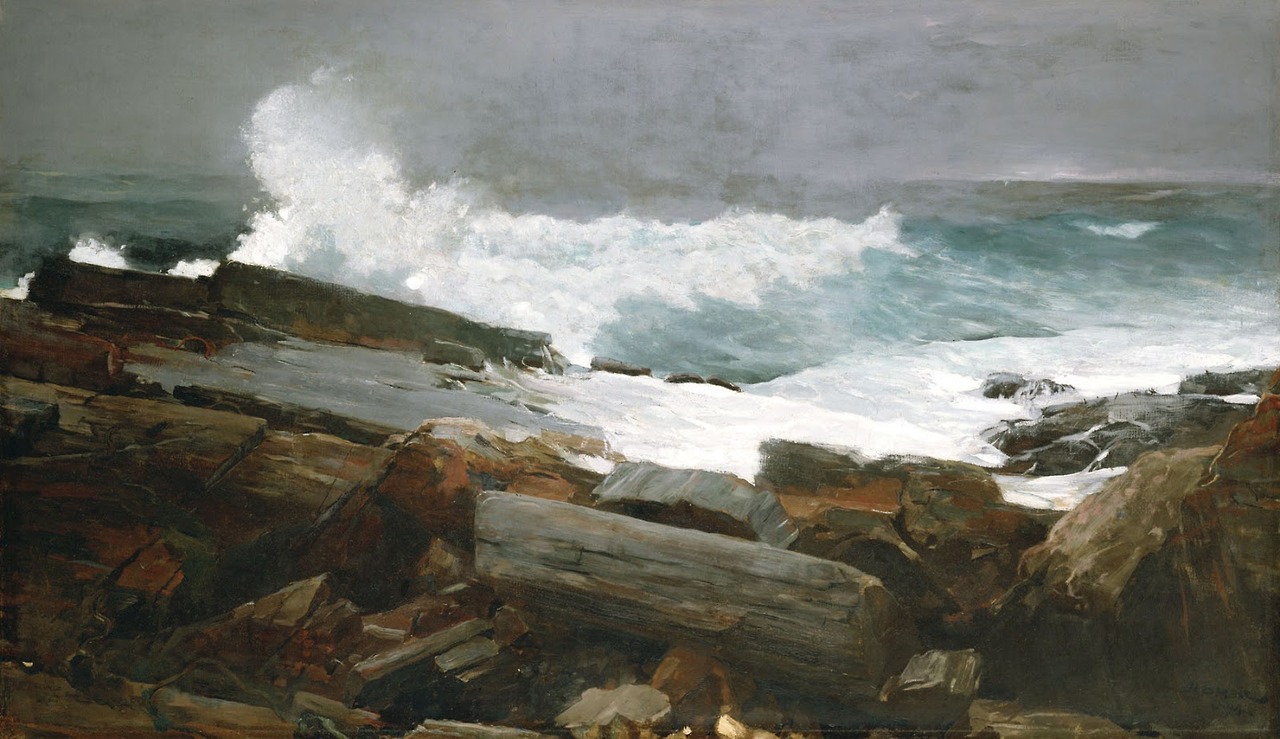EXHIBIT: Art and Artists Exhibit (under construction…..)
From Winslow Homer to Mary Anne von Stade, and everyone in between — artists, architects, etc.
 Winslow Homer, artist (1836-1910)
Winslow Homer, artist (1836-1910)
Before settling in Maine, Homer had been a successful painter and illustrator, traveling up and down the eastern seaboard. He had emerged as a charming, wholesome limner of America at leisure. But as he neared middle age, recording such tranquil idylls no longer suited him. In 1880 he summered on an island in Gloucester Harbor, followed by a year and a half in England, in the fishing village of Cullercoats, near Tynemouth. Here he had his first glimpse of the everyday bravery of fishermen as they struggled to wrest a living from the sea.
Spurred by what he saw, Homer sailed home late in 1882. He cleaned out the New York studio he had most recently occupied and repaired to Prouts Neck, a fishing village his brother Arthur had discovered in 1874. Hoping to turn the area into a summer resort, Homer’s father and brothers were busy buying up available land. Despite the artist’s growing penchant for solitude, he attempted to lodge with his family, with predictable results. “Winslow spent his first summer with his brother Charles’s family,” explains Charles Willauer, the artist’s great-great-nephew and present owner of the studio. “He realized that the hubbub was too distracting, so he asked for the stable. He moved it a short distance away and hired John Calvin Stevens, a Portland architect, to remodel it.”
What Homer demanded first and foremost was uninterrupted time. Privacy, unfortunately, could be his only at the expense of hospitality and upholstered comfort. As an acclaimed artist, he was a target of the social lion hunters materializing on the Neck every summer. They disturbed Homer so severely that in self-protection he erected a battery of defenses, including signs reading, “Mr. Homer Is Not At Home” and “SNAKES SNAKES MICE!”
To the villagers who left the painter alone, unless he made an overture, a different personality was revealed. Stories of his generosity and forbearance abound, especially in cases of the local tradespeople, who would tell him how to correct his pictures. Austere though it was, life on Prouts Neck was not without its amenities, for Homer was a fine cook and a connoisseur of food and drink. Another unexpected extravagance was clothing. Known for his natty dressing and proud of his trim figure, Homer ordered dozens of suits from Brooks Brothers. Strangers frequently mistook him for a stockbroker or coal baron.
 When not at the easel, Homer read, cooked, hunted, fished, gardened, built roads, and fussed about sales and prices of his works. Although he appreciated the peacefulness of a bright afternoon, sunny days exasperated him because of their uselessness as motifs. But when the skies darkened, Homer ran for his boots and oilskins. The thick of a gale, the lash of the rain, the sea hurling itself against the ancient rocks elated him.
When not at the easel, Homer read, cooked, hunted, fished, gardened, built roads, and fussed about sales and prices of his works. Although he appreciated the peacefulness of a bright afternoon, sunny days exasperated him because of their uselessness as motifs. But when the skies darkened, Homer ran for his boots and oilskins. The thick of a gale, the lash of the rain, the sea hurling itself against the ancient rocks elated him.
Out of this craggy, weatherbeaten world Homer hewed a powerful and highly original oeuvre and a life that bore out his own solid character. Of this he was fully cognizant. As he assured his brother, “The life that I have chosen gives me my full hours of enjoyment… The Sun will not rise, or set, without my notice, and thanks.”
Excerpted from “Historic Houses: Winslow Homer’s Home and Studio in Prouts Neck, Maine” by Avis Berman, a piece from the September 2012 issue of Architectural Digest.
 John Calvin Stevens, architect (1855-1940)
John Calvin Stevens, architect (1855-1940)
Like so many locations on the Maine coast, Prouts Neck in Scarborough became a fashionable summer resort after the Civil War. The great marine painter Winslow Homer vacationed there with his brother Arthur in 1875. Arthur Homer was the first family member to build a cottage on the Neck, followed by his brother Charles S. Homer, Jr., who engaged Francis H. Fassett and John Calvin Stevens to design The Ark in 1882.
Charles S. Homer, Jr. hired Portland firm Fassett and Stevens to design “The Ark” in 1882, which first brought architect John Calvin Stevens to Prouts Neck. The following year Winslow Homer decided to make Prouts his permanent residence and turned to Fassett and Stevens to convert The Ark’s mansard roofed stable into a studio and home. During this period the Homers acquired extensive holdings on Prouts Neck, where they would play a central role in developing a summer colony in the next three decades. In 1900 the Homer brothers, Arthur, Charles, Jr., and Winslow each commissioned John Calvin Stevens to plan a rental cottage.
Excerpted from page 26 of John Calvin Stevens: Domestic Architecture, 1890-1930 by John Calvin Stevens II and Earle G. Shettleworth, Jr., 1990.

